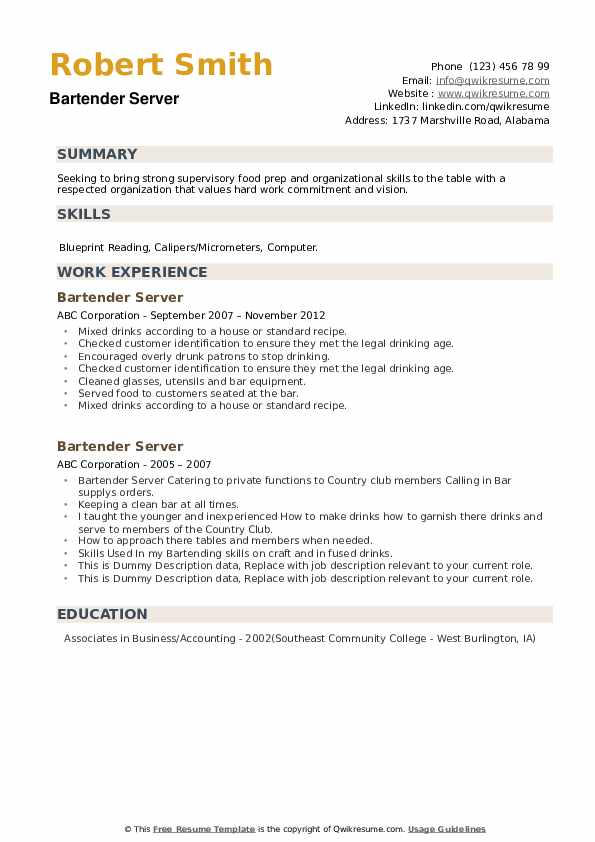
Quat sanitizer has excellent germ kill ability, low toxicity and corrosivity, it has no odor and is safe to use on almost all surfaces. Cutting boards need to be cleaned and sanitized before and after every use Cloth & Spray Bottle Used to clean and sanitize the bar, spray bottles are filled with Quat sanitizer and water. Always remember to put a damp cloth underneath to stop it from sliding. Always ensure they are properly washed Cutting Board Used when cutting garnishes and doing bar prep. Cloth -‐ Microfiber Used for polishing glasses streak, and lint free.
#BARTENDER TRAINING PDF FULL#
Ensure they are full of ice the ice should touch the bottom of the inserts. 5 Garnish Caddy Used for safely storing cocktail garnishes. and may not be reproduced without the proper written authorization. These documents are the property of FAMOSO INC. Bartender Training Guide V1 _ FAMOSO INC. Provide guests with showmanship done with their own sense of confidence and style.Deliver the bartenders brand of hospitality.Demonstrate skills essential to bartender.BARTENDER TRAINING GUIDE -‐ Learning Objectives Upon completion of training the employee will be able to: We have identified the main skills as knowledge, skill, speed, and style, and will all be covered throughout this training guide. Understanding the main skills is vital to succeed in the bar industry and being able to master them is vital in becoming an outstanding member of the bartending world. What makes a great bartender? First we need to identify the core skills needed to become a great bartender and then we can look at the other qualities that will make you a just a little bit better than everyone else. The world is full of bartenders, some good, some bad and some great. The modern bartender still needs to be a multi-‐skilled individual focused on providing great tasting drinks in a fast efficient manner while giving their guests memorable experiences to enjoy and remember. Over the last two hundred years or so the range of products available has increased greatly so most modern bartenders don’t need to make their own liqueurs to create good cocktails, however the role of the bartender has not changed significantly since the early days. The term mixologist comes from these early days of the bartending, as they had to be chemists as well as bartenders. Most bars in those days only carried a very simple range of spirits usually whisky, rum, brandy and gin but they would carry raw spirit with which to create their own liqueurs, vermouths and bitters. Originally bartenders didn’t have the range of products we take for granted today, so if they wanted to make a cocktail with orange curacao they generally had to make the curacao from scratch. The role of the bartender has evolved over the last two hundred years or so. This is usually a view held by the people on the other side of the bar, very few people ever really know just how much dedication, training, confidence and hard work is required to be a great bartender. 2 ROLE OF THE BARTENDER Ever since the first bartenders started mixing and serving drinks back in the 1800’s the profession has been regarded as rather “glamorous”.
#BARTENDER TRAINING PDF PDF#
Short ringing - pouring call, ringing well and collecting call paymentĢ.Download Bartender Training Guide and more Theatre Study notes in PDF only on Docsity! Bartender Training Guide Bartender Training Guide V1 _ FAMOSO INC. Complaining to customers about bar operations, management or co-workersīARTENDING TECHNIQUES RESULTING IN TERMINATIONġ.Coming to work under influence of drugs or alcohol.



28ĭrink Service & Delivery.29īartender & Customer Transaction Times.29ĪNATOMY OF A COCKTAIL. Guest Check Presentation, Delivery and Retrieval. Payment Methods.16Ĭash Handling Sequence.17Ĭredit Card Preauthorization.17Ĭredit Card Authorization for Total Amount.17 13Īwareness Sequence of Service and Response.13
#BARTENDER TRAINING PDF PRO#
Pro Active Bartending.11Īlcohol Consumption & Tolerance.


 0 kommentar(er)
0 kommentar(er)
